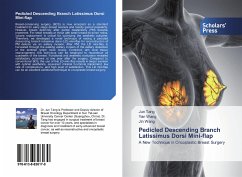Breast-conserving surgery (BCS) is now accepted as a standard treatment for early stage breast cancers and rapidly gained popularity. However, breast deformity after partial mastectomy (PM) became prominent. For small breasts or those with small breast-to-tumor ratios, volume replacement is critical for optimizing the aesthetic outcome. Therefore, we devoloped a novel technique of raising a pedicled descending branch latissimus dorsi (LD) mini-flap for reconstruction of PM defects via an axillary incision. After PM, the LD mini-flap is harvested through the existing axillary incision of the axillary dissection or the sentinel lymph node biopsy. Combined with local tissue rearrangement, this technique can be employed to reconstruct all quadrants of the breast. Functional and aesthetic evaluation revealed satisfactory outcomes at one year after the surgery. Compared to conventional BCS, the use of this LD mini-flap results in larger excision with optimal aesthetics, equivalent minimal functional impairment, low rate of complications, and high level of satisfaction. This LD mini-flap can be an excellent additional technique to oncoplastic breast surgery.








